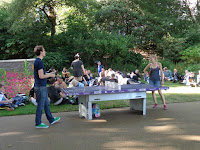For my last three-day weekend in the United Kingdom, I made a dog-delivery trip to settle in Sage at our next post, Kyiv. TJ was asked to arrive a month earlier than I could depart London, which meant we would have different home leaves, but at least I wouldn't have to haul Sage halfway around the world and back in a span of less than a month. Plus, I got the chance to preview the Ukrainian capital.
TJ knew the best way to make a good first impression would be to start me off with a drink, so after I dropped off my bags at our apartment, he took me to Old Bar, a hidden spot with a huge amount of beers on tap and in bottles (top left). It was here that I first became familiar with Tzipa Brewery, which has a tiny tasting room in Besarabsky Market (top right). It's a convenient location, as customers can procure a charcuterie plate by simply stepping out to the nearest vendor stall (bottom left). It's the more up-scale and touristy market, as compared to Zhitny Market, the locals shopping center in Podil (bottom right).
I did my part, too, by finding out in advance about a Craft Beer Fest, where we actually snacked on some charcuterie (top left). Inside the Expo Center, the event seemed like any other beer festival I've attended: You buy batches of tokens to exchange for varying sizes of beer at brewers' booths (top right). But this was the first beer festival where the adjacent grounds were filled with beanbags where tasters could drink, or eat from variety of food trucks (bottom left). A little drizzle didn't deter most of the attendees, whose perseverance was rewarded with a dazzling rainbow (bottom right).
Beyond the rainbow, Kyiv is generally a colorful city, much to my surprise. I thought I would see a lot of large, grey Soviet-style buildings, but instead, I saw Taras Shevchenko University, a Russian classicist number in rose (left). The administration building sits right across from Shevchenko Park, whose central statue of the father of Ukrainian literature is often surrounded by market stalls (right).
The center of history in the city, both literally and figuratively, is Independence Square, or Maidan Nezalezhnosty (left). In case you can see it, the slogan in the background reads, in English, "Freedom is our Religion." Although it is named in honor of the country's independence from the Soviet Union in 1991, it continues to be ground zero for ongoing freedom movements, such as the 2004-2005 Orange Revolution and the 2014 Euromaidan revolution. Despite its independence, symbols of the city's Soviet past still linger, such as an outlet of TsUM department store, a Russian-based company, located a few blocks from the square (right).
Even before independence, Ukrainian cities established events to mark their cultural distinction. The capital declared its first Kyiv Day in 1982; it is celebrated each year the last weekend of May, which happened to coincide with my visit. Most of the festivities were held in Sofia Square, home to St. Sophia Cathedral, a UNESCO World Heritage Site (top left). From the square, it is a short stroll to St. Andrew's Church (top right), which marks the apex of Andrew's Descent, a winding street that some people say shares a vibe with Paris' Montmartre (bottom left). We emulated the Bohemian lifestyle of writers such as Mikhail Bulgakov by stopping for a bit at a streetside cafe (bottom right).
The road funnels pedestrians into Podil, a historic neighborhood that has become a hipster haven. The district's revitalization is apparent in its many building murals, including "Vidrodzhenia," or Renaissance (top left). Podil abuts the city's river port, where tourists can board ships for river cruises. TJ and I opted to stay on land and head over to Trukhaniv Island, a "summer resort" accessed by a pedestrian bridge (top right). From the center of the span, we could take in the extent of the Podil skyline from which we walked -- and where we likely would be visiting again many times in the future (bottom).



























































